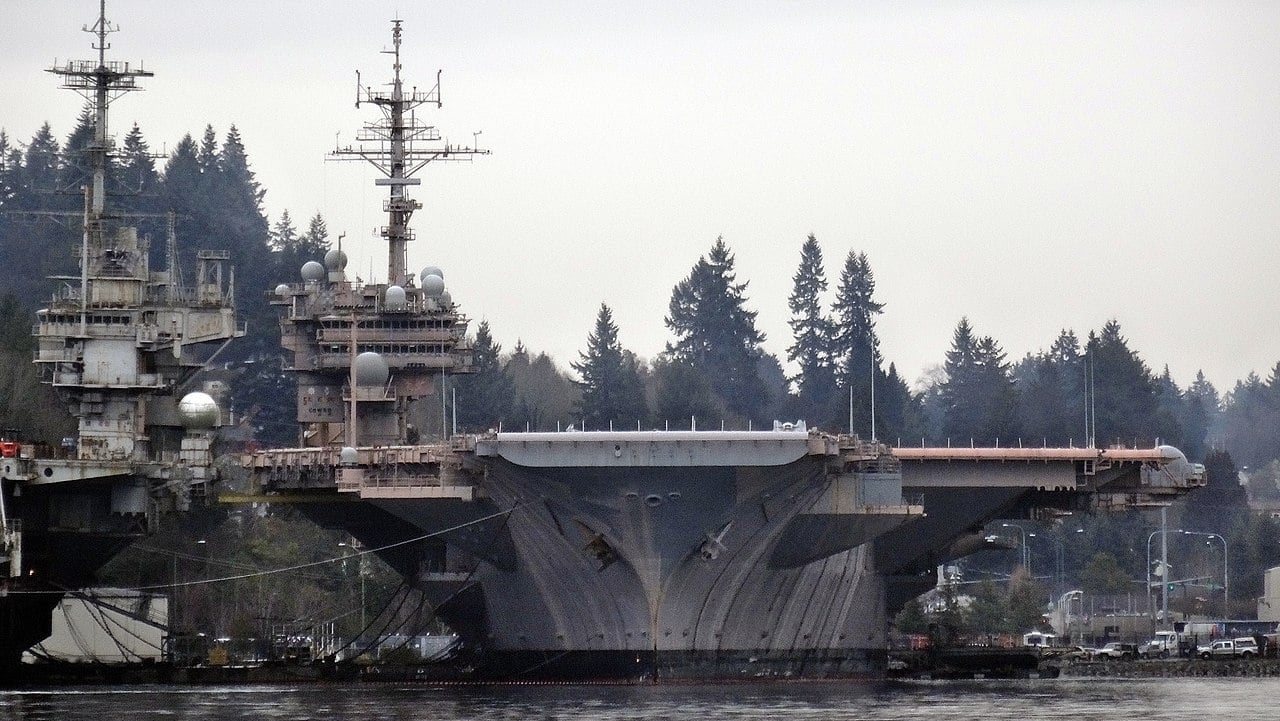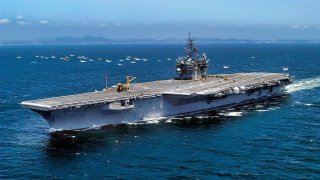Why Didn't the U.S. Navy Give India the Aircraft Carrier USS Kitty Hawk?
A few years back, the decommissioned United States Navy supercarrier USS Kitty Hawk (CV-63) arrived in Brownsville, Texas for scrapping. Why didn't the U.S. Navy give the aircraft carrier to India?
A few years back, the decommissioned United States Navy supercarrier USS Kitty Hawk (CV-63) arrived in Brownsville, Texas for scrapping. The iconic warship, which served in the U.S. Navy for 50 years and had cost $264 million to build in 1961 ($2.5 billion in 2022 dollars), was sold to the scrap company for just one cent.
She was the second naval ship to be named after Kitty Hawk, North Carolina, the site of the Wright Brothers' first powered flight. During her five-decade career, USS Kitty Hawk participated in combat operations in the Vietnam War and later took part in the invasions of Iraq and Afghanistan. From 2008 to 2012 CV-63 also had the distinction of being the U.S. Navy's second-longest active warship after the sailing ship USS Constitution – and for her final decade in service, she was the service's forward-deployed carrier, based at Yokosuka Naval Base, Japan.
Design of the new class of aircraft carriers began in the 1950s with the goal of improving upon the Forrestal-class, the first completed class of "supercarriers." Displacing 61,000 tons and 1,047 feet in length, USS Kitty Hawk would still be larger than any other non-U.S. Navy carrier in service today and would only be surpassed by the People Liberation Army Navy's (PLAN's) Fujian Type 003 carrier, which was launched last month.
USS Kitty Hawk: End of the Line, End of an Era
In 2005, the U.S. Navy announced the Nimitz-class nuclear-powered aircraft carrier USS George Washington (CVN-73) would replace USS Kitty Hawk at the United States Fleet Activities Yokosuka, Japan. The decommissioning process began three years later, and the vessel was officially retired in 2019 in Bremerton, Washington.
However, as her fate was decided, the USS Kitty Hawk Veterans Association successfully raised $5 million to preserve the retired flattop as a museum ship. Sadly, the Navy deep-sixed the plan, and along with the USS John F. Kennedy (CV-67), she was sold to International Shipbreaking Limited for just a penny.
With the scrapping of those ships, it is unlikely that the country will see another aircraft carrier transformed into a museum ship.
Alternative Use: Donate Her to India
As the vessel was being readied for retirement, rumors circulated in early 2008 that the U.S. Navy was seeking to sell – possibly even donate – USS Kitty Hawk to India. The rumors picked up traction as talks stalled between Moscow and New Delhi over the sale of the former's Kiev-class aircraft cruiser Admiral Flota Sovetskogo Soyuza Gorshkov. That warship had originally been commissioned as Baku and served in the Soviet Navy from 1987 to 1991 before the dissolution of the Soviet Union.
Cash-strapped Russia, which had renamed the vessel, continued to operate it for another five years but opted to look for foreign buyers. India, which had previously operated former Royal Navy flattops, was initially an eager – even over-eager – party, but interest from New Delhi slowed as the two sides negotiated the price.
In the end, India did buy the Russian warship, which was renamed INS Vikramaditya. It was hardly a good deal for India, which reportedly paid $2.3 billion. Even with a refurbishment, the warship has been plagued with severe problems and has suffered through three fires that put into question its reliability. Yet, for Moscow, it was a very good deal – as in addition to unloading a warship that would have as likely been scrapped, it tied the Indian Navy to Russian-made aircraft that operated from the flattop.

Kitty Hawk for India?
Perhaps New Delhi should have called Washington to inquire about the Kitty Hawk.
Back in 2022, the question had been asked in the Indian media, why didn't the U.S. sell the carrier to India?

It certainly should be seen as a missed opportunity for Washington. The United States Navy made virtually nothing from selling the USS Kitty Hawk, and it likely cost millions to ready the vessel for the scrappers.
More importantly, the Indian Navy has eyed the Boeing F/A-18 Super Hornet, which has long been touted as the premier carrier aircraft in the service today, and Kitty Hawk has operated the aircraft for years. In many ways, the United States could have taken a cue from the "razor blade business model" – as in give away the carrier, which wasn't worth anything, and sell India the hardware to use with it. Selling – even donating – the carrier to New Delhi would have helped tie the country closer to Washington and could have allowed India to have a carrier on par with anything in service with the People's Liberation Army Navy (PLAN).

As recently as 2017, there was even talk among U.S. Navy officials about bringing Kitty Hawk out of mothballs to help it reach a goal of having a 12-carrier fleet. Instead, it and CV-67 are heading to the scrap heap when they could be sailing in the waters of the Indian Ocean and serve as a deterrent against Beijing.
About the Author: Peter Suicu
Peter Suciu is a Michigan-based writer who has contributed to more than four dozen magazines, newspapers and websites. He regularly writes about military hardware, firearms history, cybersecurity and international affairs. Peter is also a Contributing Writer for Forbes. You can follow him on Twitter: @PeterSuciu. You can email the author: [email protected].


